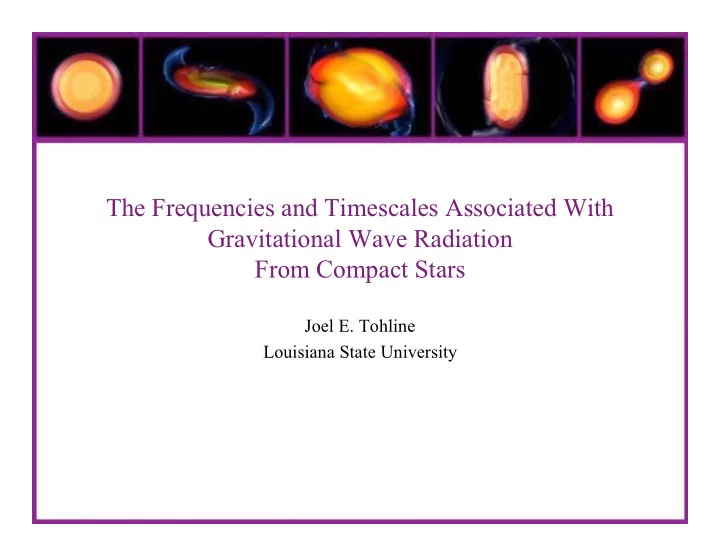

The Frequencies and Timescales Associated With Gravitational Wave Radiation From Compact Stars Joel E. Tohline Louisiana State University
Forget That!! I’d rather present a summary report from …
Structure, Stability & Dynamical Behavior of Compact Astrophysical Objects A Discussion Meeting Sponsored by Center for Gravitational Wave Phenomenology Penn State University 23 - 27 October 2002
Structure, Stability & Dynamical Behavior of Compact Astrophysical Objects Discussion Group’s Primary Participants: • Nils Andersson • Ben Owen • Beverly Berger • Nick Stergioulas • John Friedman • Joel Tohline • James Imamura • Anna Watts • Ian Jones • Kostas Kokkotas • Norman Lebovitz
Instability Mechanisms Discussed • Purely Hydrodynamical, in the presence of Newtonian gravity – Dynamical f-mode (bar-mode) – Instabilities in “ellipsoidal” figures • Driven by Gravitational Radiation-Reaction Forces – r-mode – Secular f-mode (Dedekind-like)
Issues Discussed in the Context of Each Instability Mechanism • Mode Identification – Pattern Frequencies ( f ) – Growth rates ( τ grow ) • Damping Mechanisms ( τ damp ) NOTE: α = δ q/q ∝ e -t/ τ , where τ −1 = [ τ damp ] −1 - [ τ grow ] −1 • • Expected maximum amplitude & duration • Effects of GR on mode character & damping mechanisms • Likelihood of producing a detectable GW signal
Dynamical f-mode (pt. 1) f ≈ 1 kHz ( ρ / ρ nuc ) 1/2 Behavior depends on NS’s angular momentum distribution! • For most (relatively shallow) j( ϖ ) distributions: – Instability encountered only if T/|W| > 0.27. – τ ≈ τ grow ≈ 1 ms ( ρ / ρ nuc ) -1/2 – Once encountered, almost certainly will grow to nonlinear amplitude. – Newtonian simulations suggest nonlinear bar will persist for many (>10-100) oscillation periods. – Presently unclear how GR (or shocks or viscosity) will affect duration of signal. – Unclear whether NSs will ever reach this state.
Dynamical f-mode (pt. 2) f ≈ 1 kHz ( ρ / ρ nuc ) 1/2 • For steep j( ϖ ) distributions [Shibata, Karino & Eriguchi 2002] : – Instability encountered for T/|W| at least as small as 0.03. – τ grow » 1 ms ( ρ / ρ nuc ) -1/2 – Newtonian simulations show small limiting amplitude. – Duration presently uncertain. – Results need to be confirmed. – Damping effects not yet examined. – Effects of GR not known. – Unclear whether NSs will ever reach this state.
r-mode f ≈ Ω rot --- 0 < f < Ω K ≈ 1 kHz ( ρ / ρ nuc ) 1/2 • τ grow » 1 ms ( ρ / ρ nuc ) -1/2 • • Inviscid simulations driven by exaggerated F RR show growth to nonlinear amplitude, then burst. • More than one likely source of damping – Mode-mode coupling (suggested by both “analytical” and simulation work). – Viscosity due to “funny” particles. – Magneto-viscous and/or shear instabilities (particularly relevant to LMXBs?) • Looks like high-order modes disappear when GR effects taken into account. • May survive at low limiting amplitudes (e.g., LMXBs)
Secular f-mode • 0 < f < 1 kHz ( ρ / ρ nuc ) 1/2 • τ grow » 1 ms ( ρ / ρ nuc ) -1/2 • Instability with reasonable growth rate encountered only when T/|W| relatively large. • Nonlinear simulations of this instability not yet available. • What about likely source of damping? – Mode-mode coupling not yet examined – Viscosity likely to suppress growth in many systems, but there may well be a regime where τ damp >> τ grow . • Work underway to characterize these modes in full GR.
Elliptical Instability • “New” instability not previously discussed in context of compact stars [Lebovitz & Lifschitz 1996, ApJ, 458, 699] • Virtually all ellipsoidal flows will be dynamically unstable to a multitude of long- and short-wavelength velocity and/or shape distortions. • Not discussed as source of gravitational-wave radiation; rather, it may serve as a hydrodynamical mechanism that severely limits amplitude of other (f- and r-) modes. • Not yet examined in compressible systems. • Nonlinear development not known.
Other (related) Issues • Fizzlers – If they exist, enhances likelihood of unstable f-modes (both secular and dynamical) – But existence sensitive to angular momentum distribution of pre- collapse core. • Effects of shear on discrete modes in both Newtonian and GR systems. • May need to pursue two-fluid and superfluid simulations. • Need to construct steady-state “triaxial” configurations – Effect of F RR on evolution – Linear and nonlinear examination of “elliptical” instabilities • How do we perform “slow” evolutions?
Likely Sources of Detectable GW Signals? • Dynamical f-mode – Pessimistic: Unlikely T/|W| ever going to be high enough
Likely Sources of Detectable GW Signals? • Dynamical f-mode – Pessimistic: Unlikely T/|W| ever going to be high enough • Secular f-mode – More pessimistic: Unlikely T/|W| going to be high enough and some sources of damping already identified
Likely Sources of Detectable GW Signals? • Dynamical f-mode – Pessimistic: Unlikely T/|W| ever going to be high enough • Secular f-mode – More pessimistic: Unlikely T/|W| going to be high enough and some sources of damping already identified • r-mode – Most pessimistic: Damping mechanisms in abundance � amplitude never gets very large
Recommend
More recommend